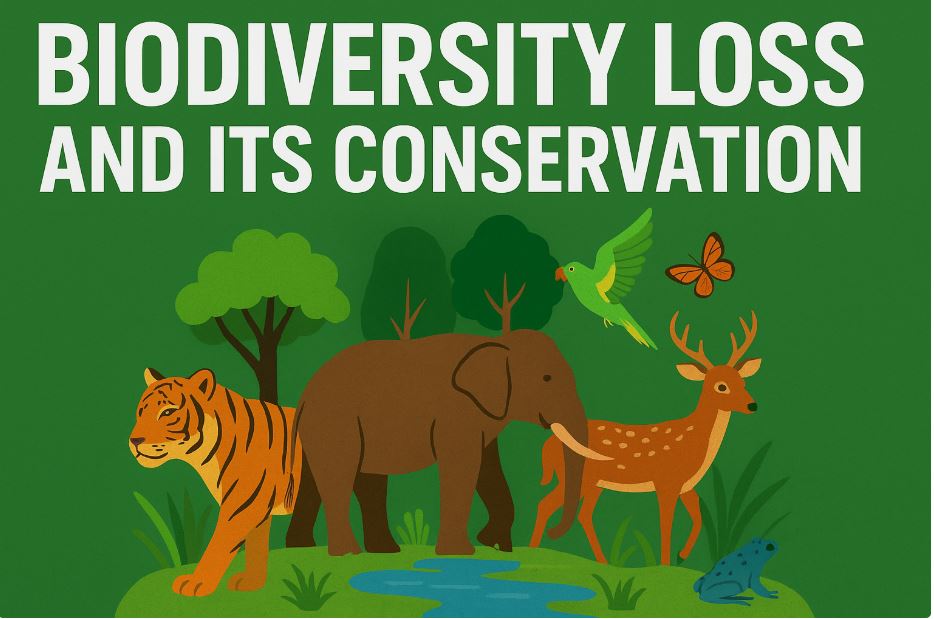Biodiversity Loss and Its Conservation

Introduction: Why Biodiversity Matters More Than Ever
Biodiversity—the variety of life on Earth—keeps our ecosystems balanced, our food systems stable, and our planet habitable. Yet, rapid biodiversity loss has become one of the biggest environmental crises of our time. From disappearing forests to vanishing pollinators, this decline threatens not just wildlife but also human survival. In this blog, we’ll explore what biodiversity loss is, its causes and impacts, and how conservation efforts can help reverse the trend.
What Is Biodiversity?
Biodiversity refers to the variety of all living organisms on Earth—plants, animals, fungi, and microorganisms. It exists at three key levels:
- Genetic diversity: variation within species.
- Species diversity: the number of different species.
- Ecosystem diversity: the range of habitats and ecosystems.
This diversity underpins essential services such as pollination, soil fertility, water purification, and climate regulation.
Understanding Biodiversity Loss
Definition
Biodiversity loss is the decline or disappearance of biological diversity in ecosystems. This can mean fewer species, smaller populations, or the complete extinction of certain plants and animals.
Main Causes of Biodiversity Loss
- Habitat destruction – Deforestation, urbanization, and agricultural expansion.
- Climate change – Altering ecosystems and migration patterns.
- Pollution – From plastics to pesticides harming wildlife.
- Overexploitation – Overfishing, hunting, and unsustainable resource use.
- Invasive species – Non-native species outcompeting local wildlife.
Impacts on Humans
- Reduced crop yields due to loss of pollinators.
- Increased risk of zoonotic diseases.
- Loss of ecosystem services like clean water and fertile soil.
- Economic losses in industries like agriculture, fisheries, and tourism.
Conservation: The Path to Protecting Biodiversity
What Is Conservation?
Conservation involves protecting, managing, and restoring ecosystems and species to ensure biodiversity remains healthy for future generations.
Key Conservation Strategies
1. In-situ Conservation
Protecting species in their natural habitats. Examples:
- Establishing protected areas like national parks and wildlife sanctuaries.
- Implementing biodiversity-friendly land-use policies.
2. Ex-situ Conservation
Protecting species outside their natural habitats. Examples:
- Seed banks.
- Zoos and botanical gardens.
- Captive breeding programs.
3. Community-Based Conservation
Empowering local communities to manage natural resources sustainably through eco-tourism, sustainable harvesting, and education.
4. Legal and Policy Measures
- International treaties like the Convention on Biological Diversity (CBD).
- National laws banning poaching and regulating land use.
Examples of Successful Conservation Efforts
- Project Tiger (India): Helped increase the tiger population through strict protection measures.
- Great Barrier Reef Restoration (Australia): Coral regeneration initiatives.
- Seed Vault (Norway): Preserves millions of seed varieties to protect global food security.
These examples show that biodiversity loss can be slowed—and sometimes reversed—through determined action.
How Individuals Can Help
- Reduce plastic use and support sustainable brands.
- Plant native trees and create pollinator-friendly gardens.
- Support NGOs and local conservation projects.
- Educate others about the importance of biodiversity.
Future Outlook: Global Goals for Biodiversity
The UN Sustainable Development Goals (SDGs), particularly Goal 14 (Life Below Water) and Goal 15 (Life on Land), aim to halt biodiversity loss by 2030. If governments, communities, and individuals act now, we can still protect much of Earth’s biodiversity.
Conclusion & Call to Action
Biodiversity is the foundation of life, and its loss is an urgent warning sign. Conservation is not just about saving wildlife; it’s about safeguarding our own future. By adopting sustainable habits and supporting global initiatives, each of us can contribute to preserving the planet’s rich biological heritage.
💡 Want to learn more about environmental issues? Subscribe to our blog, share this article, and explore our other posts on climate change, conservation, and sustainable living.
FAQs
1. What is biodiversity loss in simple words?
It’s the decline in the variety of plants, animals, and ecosystems on Earth, often caused by human activities.
2. Why is biodiversity important for humans?
It provides food, medicine, clean water, and helps regulate the climate.
3. What are examples of biodiversity conservation?
Protected areas, seed banks, wildlife sanctuaries, and community-led conservation projects.
4. How does climate change affect biodiversity?
It shifts habitats, causes species migration, and increases the risk of extinction.
5. What can I do to help conserve biodiversity?
Use fewer plastics, support sustainable products, plant native trees, and educate others about biodiversity.